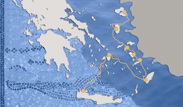The palace of the Grand Magister
The Grand Master's Palace
(Castello and Palazzo) is beyond doubt the most emblematic work of Gothic
architecture in Greece,
and a symbol
of the medieval town of Rhodes.
A building of imposing dimensions, it dominates the highest point on the north-western
side of the castle, where the Street of the Knights ends. It was built in the
ancient citadel, on the site of the ancient temple dedicated to the sun god
Helios. The palace was first founded at the same time as the Byzantine walls,
which became necessary because of repeated Arab-Persian raids from the mid-7th
century on.
The Knights of St. John erected the Castello in the 14th
century to house the city’s military and administrative centre. Under Ottoman rule,
from 1522 onwards, the palace functioned as a prison and was left to fall into
decay. It was almost entirely demolished by an explosion in an adjacent
gunpowder magazine in 1865, and owes its present form to extensive restoration
projects carried out by the Italians in the 1930's. It is a tower-shaped
rectangular building (approx. 80 x 75m) with a large paved courtyard (approx. 50
x 40m) surrounded by galleries. One of the palace’s most distinctive features
is the main gate to the south, flanked by two tall, strong round towers. The
ground floor had auxiliary rooms, while the four wings of the first floor had over
eighty or more rooms, as well as halls decorated with mosaics and frescoes
and frescoes . The
most impressive rooms are the central council room, the refectory and the chapel
. The
most impressive rooms are the central council room, the refectory and the chapel dedicated to St. Catherine.
dedicated to St. Catherine.
Since 1993 the Medieval Museum of Rhodes has been
housed in seven halls in the south-west wing of the Palace of the Grand
Masters. The permanent exhibition, entitled "Rhodes from Early Christian Times
to the Ottoman Conquest (1522)", is divided into seven rooms on the
following subjects: (a) Introduction, from Ancient to Christian Ideology; (b)
Economy; (c) Social Life; (d) Defence and Administration; (e) Intellectual
Life; (f and g) Worship and Art.
Bibliography (8)▼
Comments (0)▼
New Comment▼










